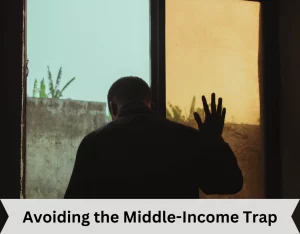ForumIAS announcing GS Foundation Program for UPSC CSE 2025-26 from 27th May. Click Here for more information.
Source: This post has been created based on the article “Avoiding the middle-income trap” published in “Business Standard” on 10th February 2024.
UPSC Syllabus Topic: GS Paper 3 Indian Economy – Indian Economy and issues relating to growth.
News: The article discusses the reasons for countries getting stuck in the Middle-Income Trap. It also highlights the characteristics of High-Income countries and India’s status on those parameters. Avoiding the Middle-Income Trap
A detailed article on the Middle-Income Trap can be read here.
What are The Future Projections for India’s Income Levels?
In 2018, the government set a target of achieving a gross domestic product (GDP) of $5 trillion by 2025. This mark looks likely to be crossed by 2027.
In per capita terms, a $5 trillion GDP means $3,600- 3,700 per capita, which is categorised as “lower-middle income” by the World Bank (between $1,136 and $4,465). “Upper-middle income” is $4,466- $13,845, and anything above is considered “high income”.
India should become an upper-middle income country by around 2030. However, many nations get stuck within that income band for decades, and some never become high-income.
What are The Reasons for Countries getting Trapped in Upper-Middle Income Level?
- Base effect: This leads to a mathematical slowdown due to a larger base (reference).
- Slower Productivity Gains: Growth also tends to slow since productivity gains become more difficult.
- Demographic Factors: By the time countries hit the high end of upper-middle income, population growth is low, and the workforce is older and smaller.
What are The Characteristics of High-Income Countries and India’s Status on Those Parameters?
| Characteristics of High-Income Countries | India’s situation |
| 1) Highly educated populations and educational systems, which help improve productivity.
| Most of the workforce has less than 10 years of schooling. |
| 2) Good laws and law enforcement, which leads to a safe physical and legal environment.
| India has a continuous undercurrent of violence. For instance, Kashmir, Manipur, Chhattisgarh. This can lead to internet shutdowns, which cripple the digital economy. |
| 3) Easily understood, moderate tax codes, applied fairly by honest officials.
| India has complicated tax and commercial codes, and corruption is also a prevailing issue. |
| 4) Reasonably good social security provisions.
| India has some welfare outreach but low spends on healthcare.
|
| 5) Almost all high-income countries are high-end democracies.
| India is classified as “Partially Free” and its democracy rankings have deteriorated.
|
| 6) Freely convertible currencies. | Due to tight currency controls, we don’t have a freely convertible rupee.
|
Read More UPSC Topics-
What Should be The Way Forward for India?
Improving Female Labour Force Participation: India is seeing lower population growth rates. However, India has very low female labour force participation. Hence, it can expand the workforce by inducing more women to work.
Changing the Business Environment: A huge legislative and administrative effort to change the business environment of India will be required.
Improving Democracy Rankings: Pushing India back up to a “free” status in democracy rankings would also be required.
Question for practice:
What is the Middle-Income Trap? What are the reasons for countries getting trapped in upper-middle income levels? How can India avoid it?





